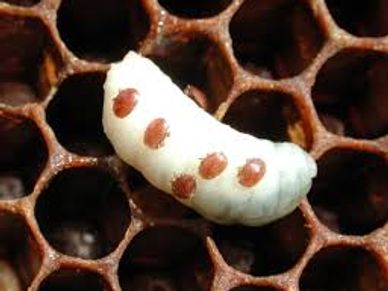Diseases & Pest
Varroa Destructor Mite
Varroa Destructor Mite
Varroa Destructor Mite

The varroa mite is an external parasitic mite that attacks the honey bees. The disease caused by the mite is called varroosis. The varroa mite can only reproduce in a honey bee colony. It attaches to the body of the bee and weakens the bee by sucking fat bodies. In this process, RNA viruses such as the deformed wing virus spread to bees. A significant mite infestation will lead to the death of a honey bee colony, usually in the late autumn through early spring. The varroa mite is the parasite with the most pronounced economic impact on the beekeeping industry. Varroa is considered to be one of the multiple stress factors contributing to the higher levels of bee losses around the world.
Hive Beetle
Varroa Destructor Mite
Varroa Destructor Mite
The hive beetle can be a destructive pest of honey bee colonies, causing damage to comb, stored honey and pollen. If a beetle infestation is sufficiently heavy, they may cause bees to abandon their hive. Its presence can also be a marker in the diagnosis of Colony Collapse Disorder for honey bees. The beetles can also be a pest of stored combs, and honey awaiting extraction. Beetle larvae may tunnel through combs of honey, feeding and defecating, causing discoloration and fermentation of the honey.
Wax Moths
Varroa Destructor Mite
Wax Moths
Wax moths are a common pest in beehives, causing damage to comb, honey, and brood. They lay their eggs near beehives or on stored beekeeping equipment. Once hatched, the larvae burrow into beeswax comb, where they feed and develop. The larvae spin silken webs as they tunnel through the comb, causing structural damage and contaminating stored honey.
The presence of wax moth larvae can weaken beehives and lead to the destruction of honeycomb and brood. Infestations are more common in weak or neglected colonies, as healthy colonies can usually defend against wax moths. In severe cases, wax moths can decimate bee colonies if left untreated.

Audubon Beekeepers Association
Henderson County Cooperative Extension Service, 3341 Zion Rd., Henderson, Kentucky 42420
Copyright © 2024 Audubon Beekeepers Association - All Rights Reserved.

